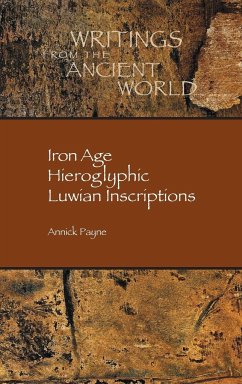Transforming Hanzi Pedagogy in the Digital Age
Theory, Research, and Practice: ¿¿¿¿¿¿¿¿¿: ¿¿¿¿¿
Herausgeber: Chu, Chengzhi; Zhang, Phyllis N.; Coss, Matthew D.
Transforming Hanzi Pedagogy in the Digital Age
Theory, Research, and Practice: ¿¿¿¿¿¿¿¿¿: ¿¿¿¿¿
Herausgeber: Chu, Chengzhi; Zhang, Phyllis N.; Coss, Matthew D.
- Gebundenes Buch
- Merkliste
- Auf die Merkliste
- Bewerten Bewerten
- Teilen
- Produkt teilen
- Produkterinnerung
- Produkterinnerung
Transforming Hanzi Pedagogy in the Digital Age ¿¿¿¿¿¿¿¿¿ brings together expert researchers and practitioners to offer a coherent theoretical, empirical, pedagogical, and experiential justification for a shift in pedagogical focus from handwriting to e-writing in L2 Chinese pedagogy.
Andere Kunden interessierten sich auch für
![The Poetry of Arab Women from the Pre-Islamic Age to Andalusia The Poetry of Arab Women from the Pre-Islamic Age to Andalusia]() Wessam ElmeligiThe Poetry of Arab Women from the Pre-Islamic Age to Andalusia75,99 €
Wessam ElmeligiThe Poetry of Arab Women from the Pre-Islamic Age to Andalusia75,99 €![Pedagogy and the Struggle for Voice Pedagogy and the Struggle for Voice]() Catherine E. WalshPedagogy and the Struggle for Voice102,99 €
Catherine E. WalshPedagogy and the Struggle for Voice102,99 €![Pragmatics Pedagogy in English as an International Language Pragmatics Pedagogy in English as an International Language]() Pragmatics Pedagogy in English as an International Language197,99 €
Pragmatics Pedagogy in English as an International Language197,99 €![Educational equity in the age of artificial intelligence Educational equity in the age of artificial intelligence]() Dr. Mara FischerEducational equity in the age of artificial intelligence19,99 €
Dr. Mara FischerEducational equity in the age of artificial intelligence19,99 €![Iron Age Hieroglyphic Luwian Inscriptions Iron Age Hieroglyphic Luwian Inscriptions]() Annick PayneIron Age Hieroglyphic Luwian Inscriptions37,99 €
Annick PayneIron Age Hieroglyphic Luwian Inscriptions37,99 €![The Cambridge Guide to Pedagogy and Practice in Second Language Teaching The Cambridge Guide to Pedagogy and Practice in Second Language Teaching]() The Cambridge Guide to Pedagogy and Practice in Second Language Teaching206,99 €
The Cambridge Guide to Pedagogy and Practice in Second Language Teaching206,99 €![A Cultural Dictionary of The Chinese Language A Cultural Dictionary of The Chinese Language]() Liwei JiaoA Cultural Dictionary of The Chinese Language80,99 €
Liwei JiaoA Cultural Dictionary of The Chinese Language80,99 €-
-
-
Transforming Hanzi Pedagogy in the Digital Age ¿¿¿¿¿¿¿¿¿ brings together expert researchers and practitioners to offer a coherent theoretical, empirical, pedagogical, and experiential justification for a shift in pedagogical focus from handwriting to e-writing in L2 Chinese pedagogy.
Hinweis: Dieser Artikel kann nur an eine deutsche Lieferadresse ausgeliefert werden.
Hinweis: Dieser Artikel kann nur an eine deutsche Lieferadresse ausgeliefert werden.
Produktdetails
- Produktdetails
- Verlag: Routledge
- Seitenzahl: 302
- Erscheinungstermin: 15. August 2024
- Englisch
- Abmessung: 240mm x 161mm x 21mm
- Gewicht: 619g
- ISBN-13: 9781032259451
- ISBN-10: 1032259450
- Artikelnr.: 70148413
- Herstellerkennzeichnung
- Libri GmbH
- Europaallee 1
- 36244 Bad Hersfeld
- gpsr@libri.de
- Verlag: Routledge
- Seitenzahl: 302
- Erscheinungstermin: 15. August 2024
- Englisch
- Abmessung: 240mm x 161mm x 21mm
- Gewicht: 619g
- ISBN-13: 9781032259451
- ISBN-10: 1032259450
- Artikelnr.: 70148413
- Herstellerkennzeichnung
- Libri GmbH
- Europaallee 1
- 36244 Bad Hersfeld
- gpsr@libri.de
Chengzhi Chu (¿¿¿) is Associate Professor of Chinese and Senior Program Advisor in the Chinese Program at the University of California, Davis, where he also serves on the Graduate Faculty of Linguistics and Second Language Acquisition. He has published widely in Chinese linguistics (grammar, lexicon, writing system, and dialect), cognitive semantics, corpus linguistics, Chinese L2 pedagogy, application of technology in Chinese teaching, and intercultural communication. Matthew D. Coss (¿¿¿) is a PhD candidate in Second Language Studies at Michigan State University. His research focuses on the multiple existing and potential interfaces between additional language learning research and practice, with particular focus on (task-based) language teaching and assessment, language program design and evaluation, and language teacher education. Phyllis N. Zhang (¿¿) is Professor of Chinese at The George Washington University in Washington, D.C. With a background in applied linguistics and language education, Dr. Zhang has authored a series of proficiency-oriented Chinese language textbooks. Her research centers around L2 language proficiency development and assessment, pedagogical grammar, and the integration of technology to enhance language instruction.
List of Contributors
Foreword Introduction PART I THEORY
1. The Evolution of Hanzi Proficiency and the E-Writing Transformation of L2 Chinese Instruction in the Digital Age
"
"
2. The E-Writing Approach to L2 Chinese Instruction: Clarifying Fundamental Principles and Core Concepts
"
"
3. Typing Characters, Priority-Setting, and Skill Integrability: L2 Chinese in the Digital Age
PART II RESEARCH
4. The Typing-Based Approach to L2 Chinese Beginner Instruction: A Study of Hanzi Instructional Design and Learning Outcomes
5. Save Your Strokes: Further Studies on the Efficiency of Learning Chinese Words Without Hand-Writing
-
6. Voice-Writing Hanzi Using Speech-to-Text Technology for L2 Chinese Learning and Instruction: An Exploratory Study
7. E-writing in Chinese as a Second and Foreign Language Learning: A Systematic Review
PART III PRACTICE
8. E-Writing Based Pedagogy to Advance Chinese Language Learning: Practices from Heritage and Non-Heritage Teaching at a Major Canadian University
-
9. Computerized Chinese to Promote the Three Modes of Communication in an Intermediate Level L2 Chinese Class "
"
10. Towards a Curricularized Approach to L2 Hanzi Teaching and Learning in the Digital Age
PART IV REFLECTIVE ESSAYS
11. To What Extent Is Writing Chinese by Hand Still a Basic Skill?
12. Handwriting or Not in the Chinese Language Classroom?
13. Chinese Character Learning for All Students
14. Rethinking the Role of Handwriting for Additional Language Learners
15. A Few Thoughts About How to Learn a Few Thousand Characters
16. From Purposeless Memorization to Purposeful Communication: Using, Not Just Writing, Chinese
--
17. Typing Chinese: An Alternate Path to Literacy and Connection
--
18. Gaining Acceptance for the Digitization of Hanzi Learning in the 21st Century
21
19. Reflections on Writing Hanzi During and Beyond School
Afterword
Index
Foreword Introduction PART I THEORY
1. The Evolution of Hanzi Proficiency and the E-Writing Transformation of L2 Chinese Instruction in the Digital Age
"
"
2. The E-Writing Approach to L2 Chinese Instruction: Clarifying Fundamental Principles and Core Concepts
"
"
3. Typing Characters, Priority-Setting, and Skill Integrability: L2 Chinese in the Digital Age
PART II RESEARCH
4. The Typing-Based Approach to L2 Chinese Beginner Instruction: A Study of Hanzi Instructional Design and Learning Outcomes
5. Save Your Strokes: Further Studies on the Efficiency of Learning Chinese Words Without Hand-Writing
-
6. Voice-Writing Hanzi Using Speech-to-Text Technology for L2 Chinese Learning and Instruction: An Exploratory Study
7. E-writing in Chinese as a Second and Foreign Language Learning: A Systematic Review
PART III PRACTICE
8. E-Writing Based Pedagogy to Advance Chinese Language Learning: Practices from Heritage and Non-Heritage Teaching at a Major Canadian University
-
9. Computerized Chinese to Promote the Three Modes of Communication in an Intermediate Level L2 Chinese Class "
"
10. Towards a Curricularized Approach to L2 Hanzi Teaching and Learning in the Digital Age
PART IV REFLECTIVE ESSAYS
11. To What Extent Is Writing Chinese by Hand Still a Basic Skill?
12. Handwriting or Not in the Chinese Language Classroom?
13. Chinese Character Learning for All Students
14. Rethinking the Role of Handwriting for Additional Language Learners
15. A Few Thoughts About How to Learn a Few Thousand Characters
16. From Purposeless Memorization to Purposeful Communication: Using, Not Just Writing, Chinese
--
17. Typing Chinese: An Alternate Path to Literacy and Connection
--
18. Gaining Acceptance for the Digitization of Hanzi Learning in the 21st Century
21
19. Reflections on Writing Hanzi During and Beyond School
Afterword
Index
List of Contributors
Foreword Introduction PART I THEORY
1. The Evolution of Hanzi Proficiency and the E-Writing Transformation of L2 Chinese Instruction in the Digital Age
"
"
2. The E-Writing Approach to L2 Chinese Instruction: Clarifying Fundamental Principles and Core Concepts
"
"
3. Typing Characters, Priority-Setting, and Skill Integrability: L2 Chinese in the Digital Age
PART II RESEARCH
4. The Typing-Based Approach to L2 Chinese Beginner Instruction: A Study of Hanzi Instructional Design and Learning Outcomes
5. Save Your Strokes: Further Studies on the Efficiency of Learning Chinese Words Without Hand-Writing
-
6. Voice-Writing Hanzi Using Speech-to-Text Technology for L2 Chinese Learning and Instruction: An Exploratory Study
7. E-writing in Chinese as a Second and Foreign Language Learning: A Systematic Review
PART III PRACTICE
8. E-Writing Based Pedagogy to Advance Chinese Language Learning: Practices from Heritage and Non-Heritage Teaching at a Major Canadian University
-
9. Computerized Chinese to Promote the Three Modes of Communication in an Intermediate Level L2 Chinese Class "
"
10. Towards a Curricularized Approach to L2 Hanzi Teaching and Learning in the Digital Age
PART IV REFLECTIVE ESSAYS
11. To What Extent Is Writing Chinese by Hand Still a Basic Skill?
12. Handwriting or Not in the Chinese Language Classroom?
13. Chinese Character Learning for All Students
14. Rethinking the Role of Handwriting for Additional Language Learners
15. A Few Thoughts About How to Learn a Few Thousand Characters
16. From Purposeless Memorization to Purposeful Communication: Using, Not Just Writing, Chinese
--
17. Typing Chinese: An Alternate Path to Literacy and Connection
--
18. Gaining Acceptance for the Digitization of Hanzi Learning in the 21st Century
21
19. Reflections on Writing Hanzi During and Beyond School
Afterword
Index
Foreword Introduction PART I THEORY
1. The Evolution of Hanzi Proficiency and the E-Writing Transformation of L2 Chinese Instruction in the Digital Age
"
"
2. The E-Writing Approach to L2 Chinese Instruction: Clarifying Fundamental Principles and Core Concepts
"
"
3. Typing Characters, Priority-Setting, and Skill Integrability: L2 Chinese in the Digital Age
PART II RESEARCH
4. The Typing-Based Approach to L2 Chinese Beginner Instruction: A Study of Hanzi Instructional Design and Learning Outcomes
5. Save Your Strokes: Further Studies on the Efficiency of Learning Chinese Words Without Hand-Writing
-
6. Voice-Writing Hanzi Using Speech-to-Text Technology for L2 Chinese Learning and Instruction: An Exploratory Study
7. E-writing in Chinese as a Second and Foreign Language Learning: A Systematic Review
PART III PRACTICE
8. E-Writing Based Pedagogy to Advance Chinese Language Learning: Practices from Heritage and Non-Heritage Teaching at a Major Canadian University
-
9. Computerized Chinese to Promote the Three Modes of Communication in an Intermediate Level L2 Chinese Class "
"
10. Towards a Curricularized Approach to L2 Hanzi Teaching and Learning in the Digital Age
PART IV REFLECTIVE ESSAYS
11. To What Extent Is Writing Chinese by Hand Still a Basic Skill?
12. Handwriting or Not in the Chinese Language Classroom?
13. Chinese Character Learning for All Students
14. Rethinking the Role of Handwriting for Additional Language Learners
15. A Few Thoughts About How to Learn a Few Thousand Characters
16. From Purposeless Memorization to Purposeful Communication: Using, Not Just Writing, Chinese
--
17. Typing Chinese: An Alternate Path to Literacy and Connection
--
18. Gaining Acceptance for the Digitization of Hanzi Learning in the 21st Century
21
19. Reflections on Writing Hanzi During and Beyond School
Afterword
Index








